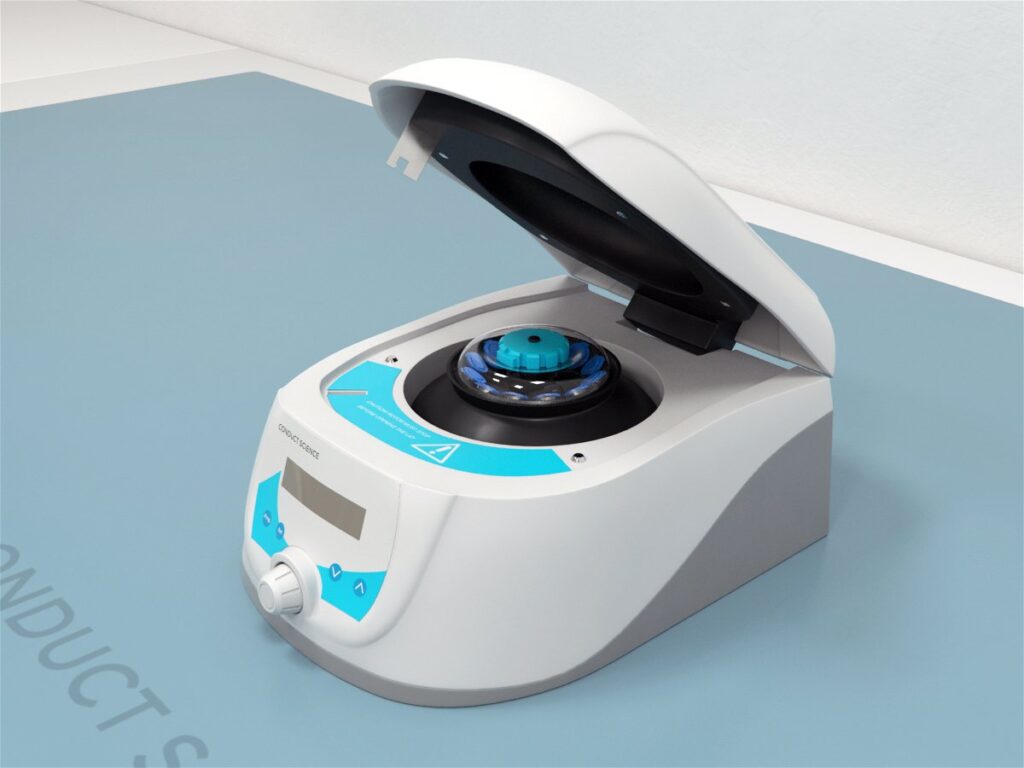

Centrifuges are one of the most frequently used instruments in research and diagnostic laboratories.
They create centrifugal force under the influence of gravity for separating liquid or gas samples into fractions. For example, to separate red blood cells from serum or plasma, or to extract nucleic acids or proteins from biological specimens.
Centrifuges are laboratory instruments that create centrifugal force by spinning sample containers around the rotation axis. The generated centrifugal force acts on the containers, including any content in them, causing them to precipitate or separate into fractions.
The magnitude or strength of the centrifugal force is relative to the rotational speed used to spin the sample, which is expressed as a multiple of the Earth’s gravitational force called relative centrifugal field (rcf) or g.
When the generated centrifugal force is larger than the gravitational force, the suspending particles will sediment into pellets, and liquids of different densities will separate into different fractions.[1-2]
Centrifugation can separate molecules based on their size and density. The sedimentation rate directly correlates with the diameters and density of the particles.
However, it inversely correlates with the viscosity of the liquid where the particles are suspended. The liquid’s sedimentation speed depends largely on its density for liquid mixtures.[2]
In general, there are two modes of centrifugation:
This is when particles in a liquid are centrifuged continuously at increasing rotational speed. During acceleration, the increasing speed causes larger suspending particles to settle to the container bottom, resulting in a pellet with layers of particles of different sizes.[2]
This mode of centrifugation is the simplest. It is applicable in various separation methods, including the spinning down step where aerosols from the upper part of the container are collected at the bottom.
This is when particles are separated in a density gradient, where a mixture of liquids is arranged from highest to lowest densities, from top to bottom. This centrifugation mode is applicable in the following manners:

At the most basic, centrifuges consist of the following two components:
The rotor’s diameter contributes to the magnitude of the centrifugal force, expressed as revolutions per minute (rpm) to represent the rotor’s rotational speed. The value expressed in rpm is used to calculate the relative centrifugal force (rcf) when the distance of the samples from the axis or the rotor diameter is known.
Centrifuges can be classified based on the maximum rotational speed into:
The first and most important point of consideration is the type of centrifuge you should consider. The answer depends on the centrifugation mode of your applications.
For example, low-speed centrifuges and microcentrifuges are sufficient for most research and diagnostic works, which generally use differential centrifugation.
However, the density gradient centrifugation mode requires high-speed microcentrifuge or ultracentrifuge. This is because they can achieve higher speed, maintain the temperature, and withstand an extended operation period.[2]
The centrifuge’s rotor is relevant to the capacity of the centrifuge, sample types, and the size of the containers that the centrifuge can accommodate.
In general, centrifuges with a horizontal rotor are regarded as the more suitable choice for the sedimentation of cells and large particles into a flat pellet.
Nonetheless, fixed-angle rotors such as Spectrafuge 6C can generate a pellet with a tilted surface where the particles sediment into a more tightly packed and more distinctive zone.[1]
Nowadays, many centrifuges possess an exchangeable rotor, providing users flexibility in the size and shape of the container. Nonetheless, the centrifuges and their rotors occupy considerable laboratory space.
Alternatively, compact centrifuges like Mini E Clinical Centrifuge provide tube adaptors that allow users to switch from 10mL tubes to 1.5-2.0mL minicentrifuge tubes without losing storage space in the laboratory.
Nowadays, low-speed centrifuges or microcentrifuges have a refrigeration or Peltier system that lowers and controls the centrifuge’s temperature during operation.
This feature generally comes with an extra cost. It’s usually not intended to counteract the heat generated during centrifugation but to protect live specimens or procedures sensitive to temperature fluctuation.
If your works or specimens can be performed in a cold room at around 4°C, consider a centrifuge like Azer Z100A Clinical Centrifuge, specifically designed for safe use in cold room operations instead of the more expensive refrigerated centrifuges.
Speed increment and reduction during centrifugation can create a violent force that can damage live samples. If you usually work with delicate samples, consider choosing centrifuges with adjustable acceleration and deceleration levels.
For example, our Azer Z206A Compact Centrifuge allows users to adjust up to 10 levels of acceleration and deceleration. Thus, centrifugal force during speed increment or reduction is fine-tuned to the sample characteristics.
Since centrifuges create a high magnitude of force to swing samples at considerable speeds, instrument failure during operation causes serious injuries to users and physical damage to the surrounding.
Modern centrifuges generally have safety features that prevent accidents and potential operational failure.
Notably, most centrifuges should have an imbalance detector that warns users if the samples are not distributed on the rotor in a balanced manner before the centrifuge rises to full speed.
Some models automatically shut down the centrifugation when an imbalance is detected. Another common safety feature is a door-locking lid, which prevents users from opening the centrifuges before the rotor comes to a standstill.[1]
Centrifuges are scientific instruments used for the sedimentation of particles or the fractionation of a fluid mixture based on size, density, and buoyancy.
Most research and clinical works are accommodated by low-speed centrifuges or microcentrifuges. However, applications that require exceptionally high speed or a prolonged centrifugation time are better served by high-speed or ultra-speed centrifuges.
Are you looking for a compact, all-around microcentrifuge? Then check out our Mini E Clinical Centrifuge.
